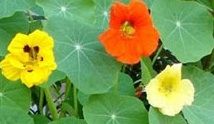Nasturtium is an annual flower that is popular as an introduction to gardening. Salad-savvy adults have probably enjoyed the peppery tang of nasturtium leaves and edible flowers among their greens.
Advertisement
Description: Nasturtiums are vigorous and can grow as either vinelike or compact bushy plants. The leaves are nearly round, and the flowers are bright oranges and yellows with long spurs behind them.
How to grow: Nasturtiums need full sun in a dry, sandy, well-drained soil. They're at their best in regions with cool, dry summers, though they will grow elsewhere, too. Bushy types get viny or stringy if they have too little sun. Sow seeds outdoors in the ground after the last frost. Depending on variety, space them 8 to 12 inches apart.
Propagation: Sow seeds where they will grow; germination takes 7 to 12 days at 65 degrees Fahrenheit. Do not cover the seeds; they need light to germinate.
Uses: Dwarf varieties are good for flower borders, beds and edging paths, and walks. Vining varieties can be tied to fences or posts and trailed from window boxes and hanging baskets.
Related varieties: Dwarf Double Jewel, in separate colors and a mix, has light yellow, gold, orange, rose, and crimson flowers. Milkmaid is a fashionable shade of pale butter-yellow.
Scientific name: Tropaeolum majus
Want more information? Try these:
- Annual Flowers. Discover your favorite annual flowers. We've organized them by color, sunlight, soil type, and height to make it easy to plan your garden.
- Annuals. There's more to an annuals garden than flowers. Learn about all of the annuals that enhance your garden.
- Perennial Flowers. Complement your annuals with these delightful perennial flowers. They are also organized by height, soil type, sunlight, and color.
Advertisement
